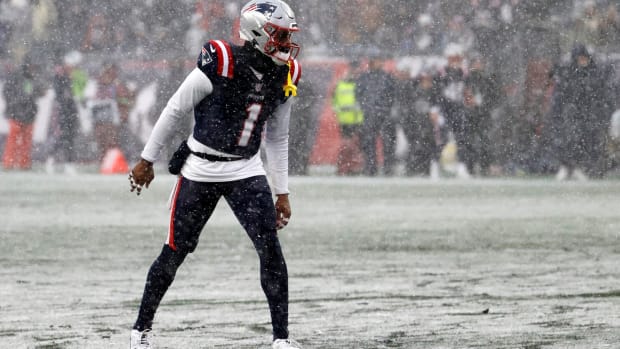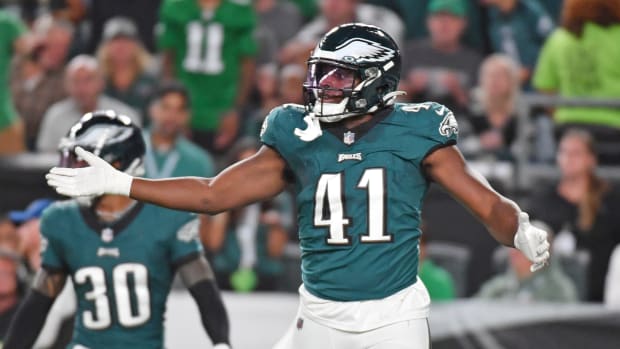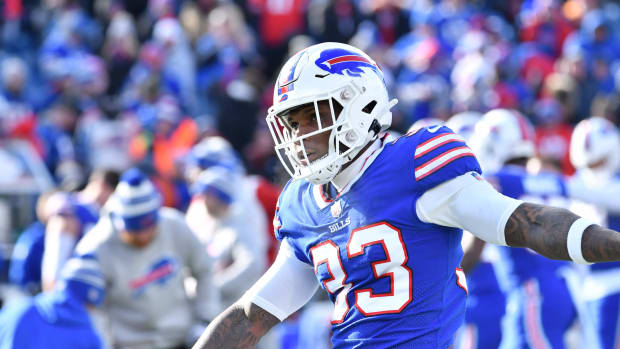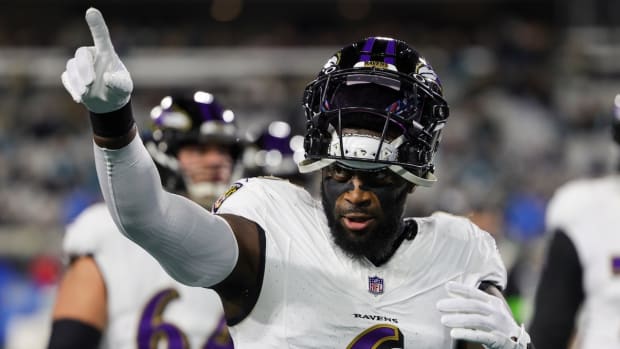SI 64: Nos. 19-17: Andrus Peat, Shane Ray and Marcus Peters
With the 2015 NFL draft fast approaching, it’s time for all 32 NFL teams to start getting their draft boards in order and ranking players based on their own preferences. At SI, it’s time for us to do that as well. To that end, Doug Farrar and Chris Burke have assembled their own definitive Big Board, consisting of the players they feel deserve to be selected in the first two rounds.
• The SI 64 (so far): Counting down top prospects in the 2015 NFL draft
As we enter the top 20, the three players detailed below are the last to have combined scouting reports—players 16-1 will all have individual profiles in the coming days. But that shouldn't minimize the potential of these prospects, who respectively could one day be a franchise left tackle, a dominant pass-rusher and a No. 1 cornerback in the NFL.
• POSITIONAL RANKINGS: QBs | WRs | RBs | TEs | Tackles | Centers | Guards
19. Andrus Peat, OT, Stanford
Bio: The son of Todd Peat, who played six seasons in the NFL as an offensive lineman for the St. Louis/Phoenix Cardinals and Oakland Raiders, Andrus Peat ranked as Sporting News's No. 1 overall prospect in the recruiting class of 2012 and started the final 27 games of his Stanford career. He was voted a second-team All-America last season (earning first-team honors from SI) and was a semifinalist for the Outland Trophy, presented to the nation's top offensive lineman.
Strengths: Fits the physical mold of a franchise tackle: tall, long arms, carries his weight well. Habitually fires his way to the second (and sometimes even third) level as a road-grader in the run game. Quick off the ball. Shows impressive awareness when on the move, which helps him pick up free defenders. Covers substantial ground on the edge of the line, perhaps most notably when he needs to shuffle wide in pass protection. Good strength when he manages to get his hands on a defender. Will stalemate a foe, then redirect with power in the opposite direction. Recognizes blitzes in time to readjust to his target. Will face a very small learning curve to get his game NFL-ready. Should step in and help right away.
Audibles Podcast: Discussing second-year players under pressure in 2015
Weaknesses: Does he have a killer instinct? Whichever team drafts him will want him to be more abrasive through the whistle. Has work to do as a pass blocker if he's ever going to be a franchise left tackle. Size helps him cover up some mistakes, but smarter, faster edge rushers will confound him if he does not clean up his technique. Is not able to stay low consistently. Balance issues are acute at times—gets off the ball in a hurry but will stand almost straight up, thereby forcing him to lunge. Appears to carry some bad weight in his midsection, so we'll have to wait and see how his game is impacted by some time with an NFL training staff.
Conclusion: While the debate on at least a couple of this draft's top-flight offensive linemen focuses on whether they should play tackle or guard (see: Brandon Scherff and La'el Collins), Peat clearly projects as a tackle. Can he take the necessary steps to man the blind side as a rookie? How teams answer that question will determine where Peat lands in the draft. Either way, he is likely to earn a Round 1 selection. The size, length and athleticism are all there for Peat to become a standout at left tackle, at least eventually. The Stanford product already has shown enough to be a reliable right tackle in 2015.
Pro Comparison:Nate Solder, Patriots (1st round, 2011)
—CB
• BEDARD: How will Falcons look in '15? | KLEMKO: The art of drafting late
18. Shane Ray, DE/OLB, Missouri
Bio: In Kony Ealy and Michael Sam, the Tigers have recently produced defensive ends with first-round talent and front-page hype, but Ray comes to the NFL with an entirely different level of potential. He led the SEC in sacks (14.5) and tackles for loss (22.5) in 2014, his first season as a full-time starter. Backing up Ealy and Sam in 2013, he still managed 4.5 sacks and nine tackles for loss. Ray's 65 tackles last season speak to the fact that he's not just a pass-rusher; he's a legitimate weapon against the run and in certain coverage concepts. The team that rounds out his skill set could be rewarded with the next great quarterback disruptor.
Strengths: Freakish athlete who has unofficially been clocked at under 4.5 in the 40-yard dash at 6'3" and 245 pounds. Moves the pocket quickly off the snap, with a dynamic first step and excellent burst around the edge. Will occasionally get past a tackle before the tackle can set his feet. When asked to read at the line, maintains a disruptive presence, moving to the ballcarrier and working to deflect passes. Resets well from a pass-rushing position to redirect and run downfield with top-level closing speed. Works to cross the face of the tackle and could be a real weapon on stunts and inside counters. Has the lateral quickness to switch to an inside gap in a big hurry. Gets his sacks too often on pure speed, but has that skill in abundance. Can generate pressure from the tackle position on passing downs. Good in coverage with potential to grow in this area. Good run-tackler who has to use recovery speed too often to mask awareness issues.
Beyond The Measurables: Markus Golden on his NFL position and more
Weaknesses: Ray uses a rip and swim move occasionally, but more consistency with his hands would be a real benefit—he's pretty unstoppable when he coordinates his speed with technique. Gets too high in his stance and loses leverage pretty quickly, and that's when blockers who shouldn't be able to move him out of the play can do just that. Needs to develop his speed at the turn, the "dip-and-rip" that makes the best pass-rushers so lethal to the tackle's outside shoulder. Foot injury prevented him from doing drills at the scouting combine, though he did some at his pro day, including linebacker drills, which may indicate where NFL teams could be considering him.
Conclusion: Outside of Nebraska's Randy Gregory, there's no edge rusher in this draft class who's quicker off the snap, and Ray has a bit more power and technique than even Gregory. But like every other collegiate pass rusher with great speed in a straight line, Ray will need to develop a more complete and aggressive set of hand moves and be stronger against the run. If he can do that and expand on a nascent ability to cover in space, Ray could live up to his potential. That would be very good news for the team drafting him, and worrisome for any quarterback having to deal with him.
Pro Comparison:Bruce Irvin, Seahawks (1st round, 2012)
—DF
• NIESEN: Can St. Louis afford to lose the Rams to Los Angeles?
17. Marcus Peters, CB, Washington
Bio: Peters will be one of the most heavily scrutinized prospects in the entire draft due to his midseason dismissal from Washington's program. Before that, Peters was benched for the first quarter of the Huskies' 2013 bowl game and later was hit with a one-game suspension because of a sideline outburst. That said, his talent is undeniable. He was headed toward All-America consideration in '14, following up on a second-team All-Pac 12 showing in '13. Peters finished his shortened Washington career with 11 interceptions.
Strengths: If you asked scouts to design a draftable cornerback, the result would look something like Peters. Terrific, well-proportioned size for a corner, and he's not hesitant to put it to work in physical coverage. Forces receivers to work extremely hard to beat press coverage. Stays planted in receivers' hip pockets downfield. Thrives on playmaking opportunities, totaling eight interceptions and 24 pass breakups combined the last two years. Seldom are the times when his receiver makes an easy catch. Steps up on run plays and hunts the action. Unlike some others at his position, Peters makes a habit of getting into the mix at or behind the line of scrimmage to find a ballcarrier. Drives through his tackles. Should continue to be a tough out in the red zone, forcing receivers outside and using his length to high-point the football.
Marcus Peters's redemption tour continues at Washington's pro day
Weaknesses: Most of the focus here will be on character concerns, thanks to Peters's early dismissal from Washington's program. Runs extremely hot during games, hence his repeated sideline run-ins with the coaching staff. Penalties and overplays could mount at the NFL level if he cannot keep his emotions in check. As is the case with Trae Waynes, likely the leading contender to be the first cornerback taken, Peters can expect some tough moments transitioning to the NFL's offense-friendly rules. He generates contact all over the field, so he'll be hit with some flags early in his career. Physical receivers that can withstand his press technique will find openings against him if they force Peters to flip his hips. Average speed (4.53 40 at the combine) may cost him a few plays on deep routes.
Conclusion: There is more than meets the eye here, in both positive and negative ways. Peters is not the uncontrollable loose cannon that his dismissal from the Washington program indicates—that he was allowed to participate in the school's pro day meant that he had not totally burned his bridge there, and several teammates reportedly talked him up after his midseason exit. But he also is not ready to step in as a No. 1 lockdown NFL cornerback, as some of his hype might have you believe. To translate all his obvious talent into a successful career, Peters must a) show that he can keep his emotions in check and b) pick up where he left off as a player by using training camp and the preseason to refine his technique. Peters very well may be the best cornerback in this draft, but nothing about his situation is set in stone.
Pro Comparison: Joe Haden, Browns (1st round, 2010)
—CB
[youtube:https://www.youtube.com/watch?v=4I5tFGvN-2w]




































